 Orange
Hawkweed (Hieracium aurantiacum or Pilosella aurantiaca)
Orange
Hawkweed (Hieracium aurantiacum or Pilosella aurantiaca)
Wild Flowers of Sleepy Hollow Lake From All-Creatures.org Art and Photo Journals and Galleries Directory
Dedicated to the Preservation and Restoration of the Whole of Creation: Humans - Animals - Environment
"And God saw all that He had made, and behold, it was very good.
And there was evening and there was morning, the sixth day" (Genesis 1:31)
Orange Hawkweed (Hieracium aurantiacum or Pilosella aurantiaca) aka Devil's Paintbrush, Tawny Hawkweed, and Grim-the-collier
Table of Contents
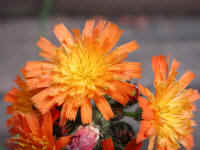
(Hawkweed, Orange (Hieracium aurantiacum or Pilosella aurantiaca) - 01)
Orange hawkweed are a native of the alpine regions of Europe that was
transplanted to North America, where in can be found in the northern United
States, including Alaska, and southern Canada. Orange hawkweed is a member of
the aster family (Asteraceae).
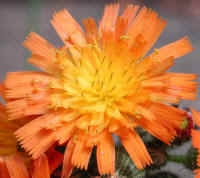
(Hawkweed, Orange (Hieracium aurantiacum or Pilosella aurantiaca) - 01a)
Each flower head of the orange hawkweed is about 3/4 of
an inch across. The bloom is really a composite of many over lapping concentric
circles of individual ray flowers. The petals are flat at the terminal end with
five points that somewhat resemble a 5-tined fork.
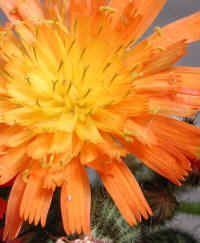
(Hawkweed, Orange (Hieracium aurantiacum or Pilosella aurantiaca) - 01b)
This is a bee's eye view of the many of the individual
flowers, with their stamens and pistils, that make up the bloom of the orange hawkweed.
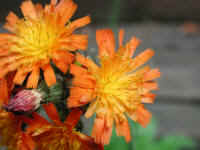
(Hawkweed, Orange (Hieracium aurantiacum or Pilosella aurantiaca) - 02)
This is another view of the terminal cluster of flowers
on the long stem of the orange hawkweed. Cattle would not eat the orange
hawkweed growing in their pastures because of the hairy nature of this wild
flower, thus farmers called it the devil's paintbrush, because it ruined good
pasture land. We can also look at this flower in another way; if we ate only a
plant food diet, as God originally intended, then we could enjoy both the
beautiful animals and wildflowers living together in the fields.
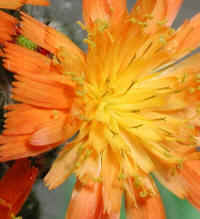
(Hawkweed, Orange (Hieracium aurantiacum or Pilosella aurantiaca) - 02a)
From our own observations of this beautiful wildflower,
it appears that the outer ray flowers are male and the inner flowers are female.
Note that the outer flowers of the orange hawkweed have curled stamens with
pollen grains, and that the inner flowers have Y-shaped pistils. Also note that
each flower has two petals, a longer bottom one and a shorter upper one, with
the stamen or pistil protruding out from between them.
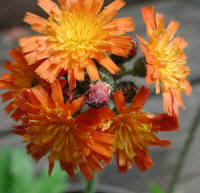
(Hawkweed, Orange (Hieracium aurantiacum or Pilosella aurantiaca) - 03)
This is another view of the terminal cluster of orange
hawkweed flowers that we found growing in a planter on our sun deck in Greene
County, New York, a county that had no previous reports of having this beautiful wildflower.
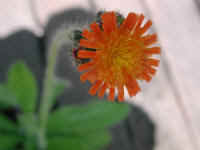
(Hawkweed, Orange (Hieracium aurantiacum or Pilosella aurantiaca) - 04)
This is another orange hawkweed that is just beginning
to bloom. Other flower buds can be seen poking out from behind the flower.
Orange hawkweed can grow to heights of about two feet.
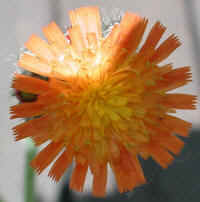
(Hawkweed, Orange (Hieracium aurantiacum or Pilosella aurantiaca) - 05)
We took this photo of the orange hawkweed because of the
contrast in the coloration between the sunlit and shaded portions of the flower.
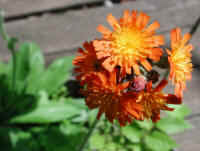
(Hawkweed, Orange (Hieracium aurantiacum or Pilosella aurantiaca) - 06)
This is another look at the terminal cluster of blooms on the orange hawkweed.
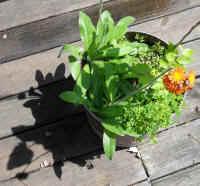
(Hawkweed, Orange (Hieracium aurantiacum or Pilosella aurantiaca) - 07)
There are two orange hawkweed plants growing in this pot
on our deck. These wild flowers reproduce in two ways: connectively in the
ground through their fibrous roots and shallow rhizomes, and through their wind-dispersed seeds.
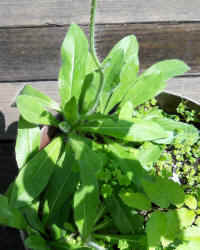
(Hawkweed, Orange (Hieracium aurantiacum or Pilosella aurantiaca) - 08) The orange
hawkweed has a basal rosette of elliptical to lanceolate leaves 5–20 cm
long and 1–3 cm broad. The flowering stem is usually leafless or with
just one or two small leaves. The stem and leaves are covered with short stiff hairs.
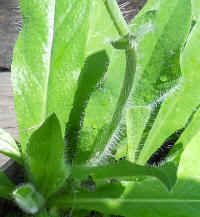
(Hawkweed, Orange (Hieracium aurantiacum or Pilosella aurantiaca) - 08a)
This is a closer look at the hairy leaves and stem of
the orange hawkweed. In the upper portion of the photo, we can see a small stem
leaf. In the bottom of the photo, we can see a new stem with a terminal cluster of buds starting to grow.
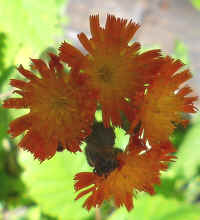
(Hawkweed, Orange (Hieracium aurantiacum or Pilosella aurantiaca) - 09)
This is another look at the terminal flower cluster of the orange
hawkweed, which we photographed on 19 June 2013 in shadow to highlight
the contrast between the flowers and the bright sunlit background. The
entire bloom is only about one inch across, and each composite flower is
only about 1/2 inch across.
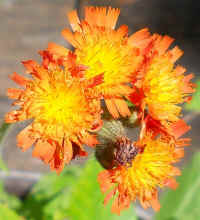
(Hawkweed, Orange (Hieracium aurantiacum or Pilosella aurantiaca) - 10)
This is the same orange hawkweed flower cluster shown in the previous photo, but this time it is on full sunlight.
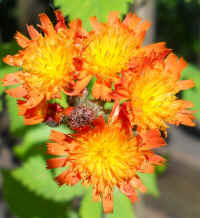
(Hawkweed, Orange (Hieracium aurantiacum or Pilosella aurantiaca) - 11)
We are always amazed and delighted at the myriad of detail that God
created into His wildflowers. We can choose to see the beauty in this
wildflower, or miss the blessing it brings, and only see the orange
hawkweed as a noxious weed, as some government agencies would have us
do. But as for us, we will always be blessed by the beauty in all His
creations, and see these plants as the wild flowers God created them to be.
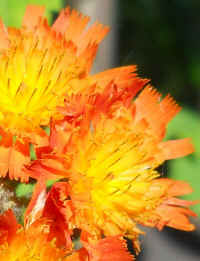
(Hawkweed, Orange (Hieracium aurantiacum or Pilosella aurantiaca) - 11a)
In this close up side-view photo of the orange hawkweed, we get a good
look at the pistils of the central disc flowers of these magnificent
wild flowers. We don't understand how anyone could fail to see God
handiwork in this flower, and give credit to the devil by calling it the devil's paintbrush.

(Hawkweed, Orange (Hieracium aurantiacum or Pilosella aurantiaca) - 12)
By comparing the blooming flowers with the dried up ones below that have
gone to seed, we can see that the ray flowers have shriveled up and
mostly fallen off leaving only the maturing disc flower ovaries to
finish developing their seeds.
| Wild Flowers of SHL: Photo Identification, Common Name, Scientific Name | Art and Photos |

 Presented here are just a few of the countless components of God's creation.
Just as we cannot have human and animal life without water and plants, neither
can we have lasting peace without love and compassion. It is our hope and
prayer that this series will motivate people to live and act in a cruelty-free
manner; that we would no longer hurt or destroy each other, the animals or our
environment.
Presented here are just a few of the countless components of God's creation.
Just as we cannot have human and animal life without water and plants, neither
can we have lasting peace without love and compassion. It is our hope and
prayer that this series will motivate people to live and act in a cruelty-free
manner; that we would no longer hurt or destroy each other, the animals or our
environment.






